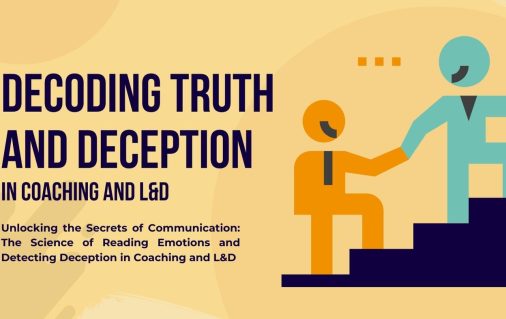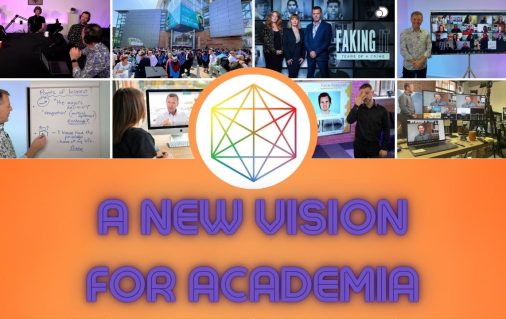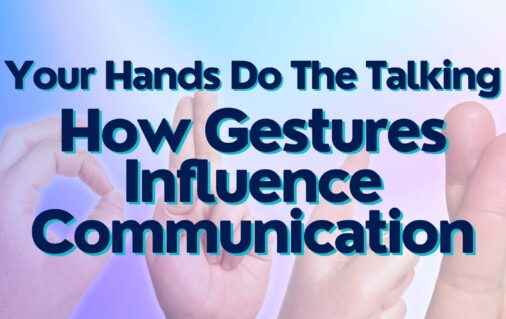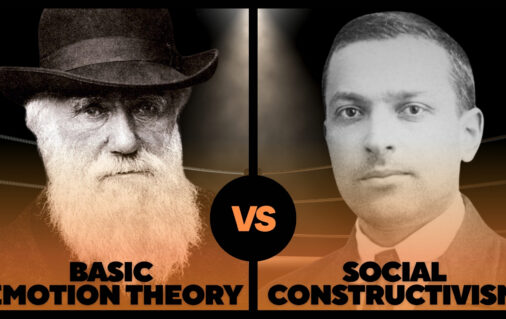How Do We Communicate?
Words…. The ways that we speak, our language style or communication style, often carries messages about our emotional and cognitive states, and whether accurate or not, others pick up on these messages and may make judgments about us.
A low-power language style is when someone’s language includes stuttering, hesitation, repetition, and unnecessary wording. These are often associated with anxiety, uncertainty, a lack of confidence and even a lack of education or economic status.
A high-power language style includes verbal fluency – which means a lack of hesitation, a diverse vocabulary, precise terminology, and logical reasoning. These are often associated with self-assurance, authority, competence, and success.
To appear more confident in your communication, just remember the acronym SEL – S stands for slow down your speech rate, E stands for engage the person that you’re interacting with, and L represents lowering your voice.
Sometimes our words betray us, instead of saying what we want to say we say what we really mean. This is known as a Freudian slip. We accidentally say what we were thinking or what we really mean, instead of what we wanted to say. This is most likely to happen if someone is lying or overwhelmed with strong emotions.
Your words and voice are often underestimated, yet they have a big impact on how you appear to others. By using your language strategically, you can enhance the effectiveness of your communication skills.
There is actually an entire area of science dedicated to understanding the meaning and intricacies behind the words that we use to communicate, how it relates to things like honesty, emotion, and power. This area of study is called Linguistics. There is an abundance of information and insight to be gained by becoming familiar with linguistic research. By understanding the details and the science behind the words we use, we can be more intentional in our communication in addition to being able to see the full picture of what others are saying.
Listening
In order to be aware of, understand and influence others, we need to listen to them and actually hear the what they are communicating.
Active listening is important in building rapport (pronounced ra-por). Rapport is the flow and ease of conversations, like comfortable and enjoyable small talk. Rapport is linked to establishing a mutual confidence or ‘mutual understanding’ (Royce, 2012: 4) and it is an essential first step in many interviewing and conversation management strategies… it is even useful in interrogations.
Active listening skills are needed for us to communicate effectively. When actively listening you are giving someone your full attention and are engaged with what they are saying, not thinking about your response.
Beyond Words
We don’t just communicate with our words, there are actually six channels we can communicate through (Lansley, 2017).
These Communication Channels are:
- Voice
- Psychophysiology
- Facial Expressions
- Body Language
- Verbal Style
- Verbal Content
Each channel can offer a unique glimpse into what someone might be thinking or feeling, and if you can interpret and find each of these puzzle pieces, together they can give you a complete picture of what someone is really communicating. In fact, a majority of the meaning behind our words is presented through our nonverbal communication.
We use our facial expressions to communicate our needs are desires and our emotions, we can also hide these things through our facial expressions, by controlling, changing, or masking our facial expressions.
You likely already do use the facial expressions of others as a tool to understand what they’re communicating… but are you sure you’re reading those facial expressions accurately and really understanding what they’re saying… or more importantly what they may be hiding?
There is a lot of years of research and science that has uncovered what facial expressions mean, what each muscle movement means, and the ways that the truth can leak out of our facial expressions. With the right knowledge and training, you can learn to see all of this. By understanding the real meanings behind someone smile, you will have more information and be more equipped to communicate and use the right strategies that can lead to a successful interaction.
Body language can seem like an intimidating topic, especially when you’re trying to have an important conversation with someone… How can you listen to them and prepare what you’re going to say, while also noticing their body language and trying to understand it? Does their body language really mean anything? Is body language analysis real and scientific? If so, what do body language changes mean?
Body language analysis is real and there is an abundance of messages that can be communicated through someone’s body language. Therefore, by understanding it we can see beyond what someone is saying, to know what they really mean.
First impressions happen in 30 seconds. In the first 30 seconds of meeting you, people will make many judgments about you; your credibility, status, competency, and likeability.
We communicate through many things. Whether we know it or not, our behaviors and objects carry messages which tell other people something about us. We may be unintentionally communicating things that are putting us at a disadvantage, professionally or personally. For this reason, it’s important to be aware of what those messages are, so that you can intentionally present yourself in ways you would like to be perceived.
How are you sitting right now? Think about it and notice, don’t change it, just notice.
Are you sitting in a way that is making you small?
Do you look competent?
Do you look powerful?
Do you look feminine/masculine?
Do you look afraid?
Your posture is a powerful tool and a major way to communicate our emotional states, status, confidence, and authority to the people around us.
The items you have, the stuff you use, and the things you wear can also present messages to others.
For example, carrying an expensive handbag or wearing a prestigious watch can be a form of status signaling. This is intentionally (or unintentionally) presenting a message to others… your status is inferred, because you have spent a lot of money on a luxury item… but this strategy is not perfect, (and the rise of imitation goods can in some instances send the opposite message).
The ideas of what items or behaviors signal high status will be different for various cultures, people, and countries. So, a luxury item that may be impressive to one group, may be viewed as distasteful or obnoxious in another group. Where one country may view high heels as a symbol of luxury and high status, (sending the message that you’re wealthy enough to afford a driver to take you places), another country may view a specific brand of locally made running shoes as a symbol of high status, because you must have the luxury of being comfortable. Or a specific age group may view wearing shoes that are hand crafted that hold a socially responsible message, such as being environmentally sustainable, as the ideal. These ideas regarding status and the objects’ meaning that is associated with them can also change overtime, so the outfits that may have made someone look successful or like an authority figure in the 1980’s is different than today.
The examples above hint at another concept proposed by PhD candidate Rob Henderson, called Luxury Beliefs. This is when a set of ideologies and beliefs are associated with social status. This can be a more subtle, yet very powerful form of status signaling (Henderson, 2019).
Additionally, wearing symbols like a cross, or wearing a wedding ring, can be a form of virtue signaling. This is when you use people’s assumptions strategically.
For instance, if you think that people assume that Christian individuals are more honest or trustworthy, then you may choose to wear a cross necklace to signal to them that you have such values or hope that they will presume that you do and are trustworthy, which could be especially useful when trying to conceal something.
Context is king though, because someone may have negative associations with Christianity and the symbol of a cross, which could result in the opposite effect.
It’s quite common for salespeople to practice this technique of virtue signaling. For example, if a salesman’s clients are family people, the salesman may wear a fake wedding ring or have a cup in their office that says, ‘world’s best dad’, because this similarity creates a sense of comfort and trust.
Clients may presume, ‘This salesman is married and a father, therefore he must be a good guy. I am also married, and a father and I am a decent person… so this salesman must be trustworthy’, making it more likely that they will make the purchase. Virtue signaling is also done unintentionally, for example if the salesman is in fact married, the clients still perceive similar messages.
We tend to trust people that we find attractive more than those who we find unattractive. This can be used to your advantage, simple things like cleanliness and fashion can create a more attractive first impression. This can relate to your overall hygiene too… your skincare, hair care, teeth, hands and fingernails, clothing, shoes, scent etc. For this reason, there are many charities that support people who are homeless by giving them professional clothes, teaching them how to dress for job interviews. Seemingly small things like creating a high-quality professional image can open up opportunities and springboard one’s efforts to reach their goals and be taken more seriously in communication.
However, this extends far beyond your physical appearance. Research has shown that perception of attractiveness increases when you help others or known to help others.
Also, when there is a feeling of closeness between you and the person you are communicating with, this makes you seem more attractive. You can also seem to be more attractive when you are empathetic and compassionate. Similarly, if you seem to be more open minded and have less judgements or prejudices, you are viewed as more attractive.
In a group situation, people were more compliant with the requests of leaders that they viewed as attractive, and overall there was more of a joint effort towards the group’s goal. In this way it is incredibly valuable for you to utilize strategies, such as being helpful and expressing compassion, especially in professional contexts where groups are working together and you are requesting things from them. People are more likely to be receptive if they view you as attractive.
This word attractive could just be replaced with likability or trust. It’s not necessarily that they are romantically attracted to you, it’s simply that they like you, they enjoy working with you, and enjoy being around you. A key aspect in this is also emotional intelligence because emotional intelligence is often needed to know when and how to help others or express compassion.
Through understanding colour psychology you can choose clothes that make you seem friendly (e.g., blue or white) or that give an impression of luxury and high-class (e.g., black and white) or that make you seem like an intimidating authority (e.g., red, navy or black) and avoid colours that make you appear cowardly (e.g., mustard yellow). In such ways colours can even be used strategically when organizing the context of an interaction, for example through art, room design, font colors, or pen colours. Colour psychology is also very useful in advertising to add another layer of influence.
It’s unfortunate that most societies and human beings do treat people differently for such superficial reasons. And sometimes it’s more fitting to not use these strategies, for example, if a tech genius is wearing a hoodie at an interview, that may appear more authentic and appropriate compared to if they were wearing a navy suit, white shirt, and red tie.
Not everyone you meet will be looking at the details of your image and making judgments about you, but that said, it’s still better to be aware and use the norms to your advantage, rather than have it be a detriment to your work, relationships, and communication.
Influencing Strategies
Actions
People often make judgments about your character based on how you treat other people. For example, how you treat wait staff. This is related to your overall manners and perceived respectfulness and kindness.
This can be used to your advantage, for example, if you encourage people a lot, they will generally like you more – but these encouragements must be sincere or they will have the opposite effect and people will view you as a manipulator. If you compliment people behind their back, it can show that you are a kind and encouraging person. For example, you compliment person C when you’re talking to person A, then person A will assume that you’re also complementing them to others. This creates a sense of goodwill.
It is a better strategy and more effective than complementing a person directly, because direct compliments, if not done right, can seem insincere or can seem like you are trying to get something from them, or ‘butter them up’.
Words
If you want ask someone for a favor, don’t ask them… at least not at first.
First, make a particularly grand and unrealistic request, expecting it to be denied and then if you make your real request afterwards, it is much more likely that the person will approve the request, because by comparison to your previous request, this next request seems a lot smaller or doable. Also, generally people want to say yes and be seen as helpful, so it’s less likely that someone will say no repeatedly.
By the request being denied initially, it gives the other person the sense that they are in control and that they can dictate the terms. As a result, they’re going to feel more comfortable and more likely to grant the second request, because it almost seems like their idea, and not that they’re being taken advantage of by fulfilling the request.
Further, because they may view the situation as under their own terms, they can feel a sense of responsibility to fulfill the request and see it through. By allowing the first request to be denied, it also seems like the person making the request has already compromised. This makes the other person feel like their needs have been regarded and respected (that they are able to set boundaries and say no), rather than feeling like there’s a power imbalance. All these things also make it more likely that someone will say yes to a second request.
People generally do want to comply and appear helpful and cooperative, or in control, as seen by the previous technique; this can be used to your advantage in the words you use.
A simple example is to ask, ‘What other questions do you have?’ or ‘What other tips can you offer?’ instead of ‘Do you have any other questions/tips?’. This suggests that someone does have other things to offer, and as a result, they will try to think of what that might be, so that they can offer it and seem cooperative, competent, or in control. The alternative of using a yes or no question makes it less likely that someone will take time to think of what more information they can offer you.
In conversation I-messages are a way to ensure that you have really understood someone, while also giving them a chance to correct you if needed. An example of an I-message would be ‘What I hear you saying is that…’. Similarly, using pauses to allow the other person an opportunity to clarify or correct you can show that you truly do want to understand them.
These small things can signal engagement and a sense of similarity and being ‘on the same page’ with you. As a result, this person will likely be much more receptive to your idea and requests, because as the liking principle explains, we generally like people who are like us.
















